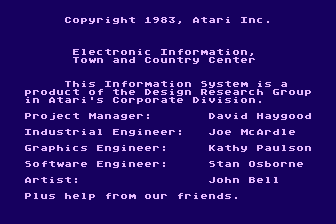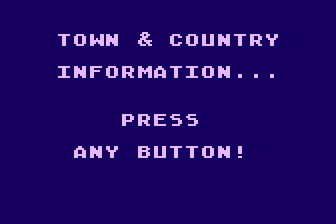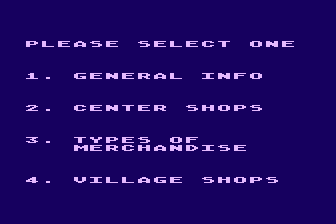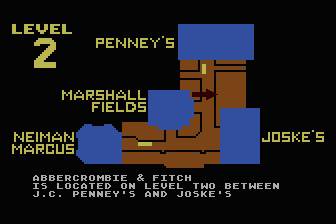|
|
Town and Country Information System
|
Name:
|
Town and Country Center
Information System |
 |
| Company: | Atari | |
|
Model #:
|
N/A | |
|
Programmers:
|
Atari Design and Research
Group David
Haygood (Project Manager)
Joe McArdle (Industrial Engineer) Kathy Paulson (Graphics Engineer) Stan Osborne (Software Engineer) John Bell (Artist) |
|
| Year: | 1983 | |
|
Released?
|
No
|
|
| Notes: |
Opening in Houston Texas in 1983, The Town and Country mall
was envisioned as an upscale mall with high end tenants such as
Neiman Marcus, Marshall Fieldís, J.C. Penney, and Joskeís.
For this reason itís thought that the mall owners reached out to
Atari to develop a new high tech information kiosk system.
This is the story of that program.

The Town and Country Center Information System was a special project being run out the Atari Design and Research group. Although an actual kiosk unit has never been found (if they were even ever built), it is thought that the unit would have run on an Atari 800 hooked up to some sort of keypad wired directly into the Atari's keyboard connector. Oddly the numbers on the screen do not correspond to the numbers on the standard Atari keyboard, which seems to indicate that the keypad was non-standard for some reason. The keys are mapped like this:
| Kiosk Key | Atari 800 Key |
| 1 |
8 |
| 2 |
9 |
| 3 |
0 |
| 4 |
5 |
| 5 |
4 |
| 6 |
3 |
| 7 |
I |
| 8 |
O |
| 9 |
P |
| # |
E |
| * |
T |
The kiosk software starts up with a splash screen displaying the main programming team and then transitions to the standard Atari Fuji Logo. After a few more seconds the program will display a nice title screen with a picture of a young woman with the name of the mall after which it will display a text screen asking the user to press a button for information. If no key is pressed the program will cycle through the Atari logo, picture of the young woman, and the press any button screen.

Upon pressing a key the user is presented with a menu of four options:
General Info - This screen allows the user to
find the location of non-shop related items such as elevators,
escalators, telephones, parking, etc..
Center Shops - This screen allows the user to find the location
of shops located in the mall itself.
Types of Merchandise - This screen allows the user to find a
shop based on the type of merchandise they sell.
Village Shops - This screen allows the user to find the location
of shops located in the outlying Village Shops area

After selecting one of the options, the map screen will appear and show the user with a map and highlight the rough location of where the selected item is with a large animated asterisk or arrow. The program will also provide a brief text description of the location underneath the map. Pressing any key will take the user back to the main menu. While this may seem rather mundane by today's standards, this was fairly high tech for the time. The Atari 800's high resolution graphics were able to depict the mall map with surprising accuracy.

Although the software seems to be fairly complete, there are a few bugs. Some of the options (such as Parking Lot under General Info) crash the system. Also of note is that the current prototype is 20K in size which is too large to be run from a standard 800 cartridge which topped out at 16K. It's unknown if the kiosk system would have taken a special cartridge of some sort or if the program would have been compressed down to 16K before being released. Also unknown is how the kiosk would be updated. Updates would have required making changes to the program and flashing new EPROMs for the cartridge This would have required sending the cartridge back to Atari each time the malls tenants changed. It's also possible the program was meant to run from disk, but this seems unlikely as a disk drive would not last very long under constant use in an environment like a mall kiosk.

Itís unknown if this software was ever finished and installed into an actual kiosk but it seems unlikely given there are no surviving accounts of the kiosk or any pictures of it in action. The Design and Research group was closed down at the end of 1983, so it's unlikely that versions for other malls were ever made. As for the mall itself, it fell into a decline during the mid-90s and eventually closed in 2004. In late 2004 the mall was completely demolished and the current CityCentre mall was built on the spot and still stands to this day.
| Version | Cart Text | Description |
| 4/29/83 | Very close to final |
